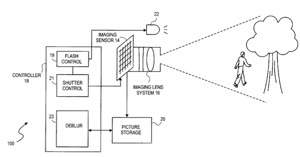Apple granted patent for Apple has been granted a patent (number 20110081142) for pulsed control of a camera flash by the US Patent & Trademark Office. An embodiment of the invention relates generally to electronic devices having a camera function (referred to here as an electronic camera device), and more particularly to techniques for controlling the camera flash.
Per the patent, input from a user is received, to take a picture. A camera flash is signaled to produce multiple flash pulses during a single shutter cycle of the picture. The amplitudes of at least two of the flash pulses are different relative to each other.
The picture is stored, including in its metadata information that describes the variable amplitude of the flash pulses that illuminated the scene when taking the picture. The information describing the variable amplitude of the flash pulses is used to deblur the picture. Other embodiments are also described and claimed. Richard Tsai is the inventor.
Here’s Apple’s background and summary of the invention: “In photography, a conventional camera flash is used to improve image picture quality in low light situations, by illuminating the scene with a burst of visible light while a picture of the scene is taken. For portable devices, such as handheld dedicated digital cameras and multifunction devices referred to as smart phones, the practical choices for an integrated, flash light source include the use of light emitting diodes (LEDs) and gas discharge lamps.
“An LED flash can be used to provide continuous illumination, which provides good illumination for capturing a rapid sequence of images, such as a video sequence. A gas discharge flash is typically operated in a pulsed manner to provide a very high intensity light but for a relatively short duration, no longer than the period of time the shutter is allowed to remain open to capture the scene for a single picture or frame. It is some times desirable to provide a less intense flash, e.g. during a redeye reduction process where the main flash is immediately proceeded by one or more reduced intensity flashes.
“Illumination by flash is provided during the image-framing period (also referred to as the single shutter cycle for taking a picture). A typical range for such a period is 200-300 milliseconds. Some LED flashes are not capable of providing their highest level of illumination for the entire image framing period, and thus have to be pulsed with, for example, one larger pulse and one smaller pulse during the entire shutter cycle. There may also be thermal reasons for pulsing an LED flash.
“In other aspects of photography, it is known that a moving object in the scene, or movement of the camera relative to an object in the scene, causes motion blur. In other words, the object appears blurred in the picture. Shortening the exposure time for taking the picture may reduce such blur, provided the image sensor is sensitive enough to capture a sufficient amount of light from the scene during the shorter exposure time. In another technique known as deblurring, a signal processing operation known as deconvolution can be applied to the picture in order to recover the high frequency or edge details that have been lost in the blurred picture.
“It has been reported that for an improved deblur operation, rather than leaving the shutter open continuously for the entire exposure duration, the camera shutter is ‘fluttered,’ i.e. opened and closed rapidly during a single exposure period, in accordance with a binary pseudo-random sequence or code.
“This flutter effectively changes the inherent filtering effect of the exposure time, in a way that better preserves the high frequency spatial or edge details in the picture, such that the subsequent deconvolution (deblurring) operation can be more easily performed to recover the edge information in the picture. This so-called coded exposure photography technique or flutter shutter technique has been suggested as being extendable to strobe lighting flashes. This coded flash sequence has been suggested to provide a greater ability to control motion sensing.
“An embodiment of the invention is an electronic device having a camera function for taking a picture, where a controller is to command a camera flash to produce two or more multi-value coded pulses of light during a single shutter cycle of the picture. As redefined here, the term ‘camera flash’ is not limited to elements that produce only visible light pulses; the camera flash can also, or alternatively, produce non-visible light pulses that can be reflected from moving objects in the scene and then detected by an imaging sensor (as a picture of the scene with the moving object).
“The pulses are said to be ‘multi-value coded’ in that the amplitudes of at least two of the flash pulses are non-zero and different relative to each other. This variation in the flash pulses inherently embeds useful information into the picture about the motion of an object, which in turn provides an effective mechanism to subsequently deblur the picture (using stored knowledge of the timing and variable amplitude characteristics of the variable flash pulses). The mechanism is also applicable in the case of video compression, to perform motion compensation across several frames of video. Having the amplitude of the flash pulses be variable yields an improved ability to subsequently discriminate the high frequency or edge components of the picture, during the subsequent deblurring or motion compensation operation.
“The above summary does not include an exhaustive list of all aspects of the present invention. It is contemplated that the invention includes all systems and methods that can be practiced from all suitable combinations of the various aspects summarized above, as well as those disclosed in the Detailed Description below and particularly pointed out in the claims filed with the application. Such combinations have particular advantages not specifically recited in the above summary.”
— Dennis Sellers

